The Sam Feinstein exhibition at the Provincetown Art Association and Museum charts his lifelong commitment to abstraction and color. The paintings span his early years in Provincetown as a student of Hans Hofmann to his final years, when he continued to work on ambitious large-scale canvases until his death in Dennis in 2003.
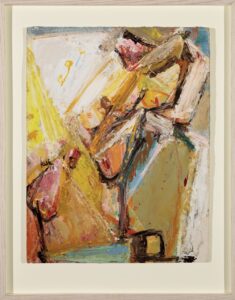
Feinstein was born in Voronovitza, Russia (now Ukraine) in 1915 and emigrated to the U.S. at five with his family. He was raised in Philadelphia, where he began his artistic career, exhibiting paintings and prints throughout the 1930s and ’40s. He also worked as a commercial artist and teacher. During World War II, Feinstein was an illustrator for the U.S. Army Medical Corps, where he was introduced to filmmaking, a skill he used years later in his 1999 documentary Hans Hofmann.
In 1949, Feinstein was looking to develop his knowledge of abstraction; he joined the postwar wave of students flocking to Provincetown to study with Hofmann.
A wall of paintings and works on paper created during Feinstein’s Provincetown years anchors the exhibition at PAAM. They show him moving from representation toward abstraction. He strives to find his own voice while experimenting with the latest developments in painting.
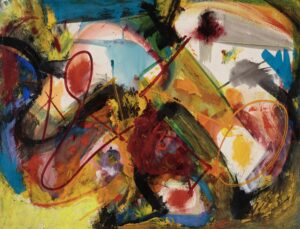
Two of his most representational works in the exhibit, both from the late 1940s, depict Provincetown Harbor in blocky cubist forms. Willem de Kooning — the hotshot of abstract expressionism — seems to be on Feinstein’s mind in a pair of oil-on-paper compositions of nude figures rendered abstractly in brazen painterly gestures. In other pieces from this period, Feinstein favors all-over compositions, freely experimenting with lines and marks. These pieces recall the surrealist roots of abstract expressionism.
These early pictures capture the excitement and sense of possibility Feinstein encountered as a student in 1950s Provincetown when abstraction captured the imagination of so many painters. The paintings that composed his mature work show their debt to these early experiments. As such, the exhibit charts the development of an artist’s voice, situating it within the geography and community from which it arose.
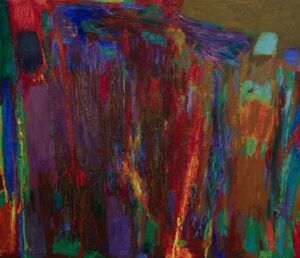
Although the show is not organized chronologically, it’s fascinating to observe Feinstein’s work develop over decades. By the late 1950s, he was firmly established as an abstract expressionist, exercising all the physical bravado of that movement. Surfaces are heavily slathered with thick, meaty paint.
In Pieta 1, he sets up a dramatic play between a primarily dark palette and a yellow slash of color that runs down from the top of the canvas. A reddish-orange shape and a passage of purple at the bottom vibrate in the composition, resounding with Hofmann’s “push and pull” theory.
In another painting from the 1950s, Untitled (Cat. 607), Feinstein organizes the picture around a similar downward diagonal thrust, conjured through an expansive field of yellow. Between the two paintings, there’s a consistent concern with dramatic tension between light and dark and movement that flows downward — or upward.
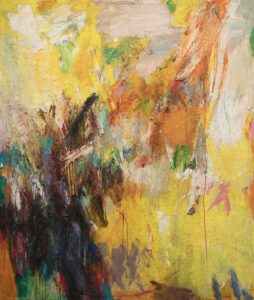
“These paintings are conceived to project their own expression, to radiate a specific presence,” said Feinstein about his own work. “They are optical structures composed to touch the human spirit, to turn a rectangle into an evocation.”
In his lifelong pursuit, color and light — as well as vertical compositions that could be alternately described as ascents or descents — became Feinstein’s physical means to evoke presence, spirituality, and radiance.
In 1960, Feinstein left Provincetown, where he had summered for a decade, and bought a house in Dennis. The rest of his life was spent in New York and Dennis. Feinstein taught private classes and, although he exhibited widely as a young artist, he kept the commercial world of galleries at arm’s length. Consequently, his work is not well known.
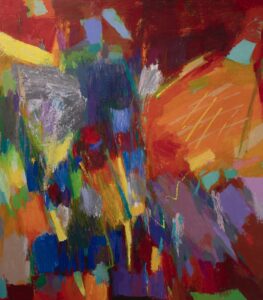
The paintings in the PAAM exhibition from the 1970s onward are done in acrylics rather than oil. His colors became brighter. A fascination with hot reds and oranges at one extreme and cool blues and purples at another would remain with him throughout his life. He became a master of color, activating these high-key hues through their relationship to muddy tonal colors. Whereas the dark colors in his early paintings often veered toward black, in his later paintings he found a whole universe of color in areas of darkness.
Just as his paintings from the 1950s echoed that decade, some of his paintings from the 1980s reverberated with the stylistic trends of their time. Their pastel colors and ample use of aqua green — along with a more stylized texture that emphasized the plastic veneer of acrylic paint — recall that decade’s fixation with all things synthetic and bright.
Feinstein’s paintings from the 1990s to 2002 show his vision most fully realized. They are sublime paintings that build on Hofmann’s notions of color and the legacy of abstract expressionism, but they are entirely Feinstein’s own.
Untitled (Cat 72) represents a continuation of his earliest obsessions: large forms fall vertically, dark colors dominate and — in an echo of Pieta from 40 years earlier — there’s a slash of bright paint falling downward and activating the space. In this case, it’s a line of bright orange paint applied straight from the tube.
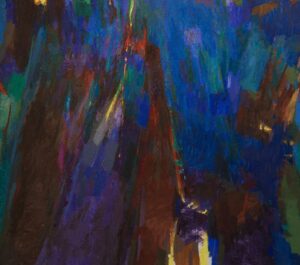
Yet, unlike Pieta, the color in this painting is perfected and his mark-making is self-assured and less derivative. Here he evokes a deep space, subtly gesturing toward landscape. His mature paintings are the stars of this show. They represent a triumph and an achievement at the end of a long road. As such, this exhibition celebrates not only Feinstein’s legacy but the journey of any artist who doggedly carves out a space for himself.
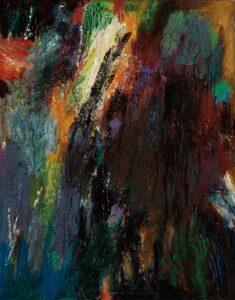
The Radiance of Color
The event: The paintings of Sam Feinstein
The time: Through Sept. 2
The place: Provincetown Art Association and Museum, 460 Commercial St.
The cost: General admission: $15



